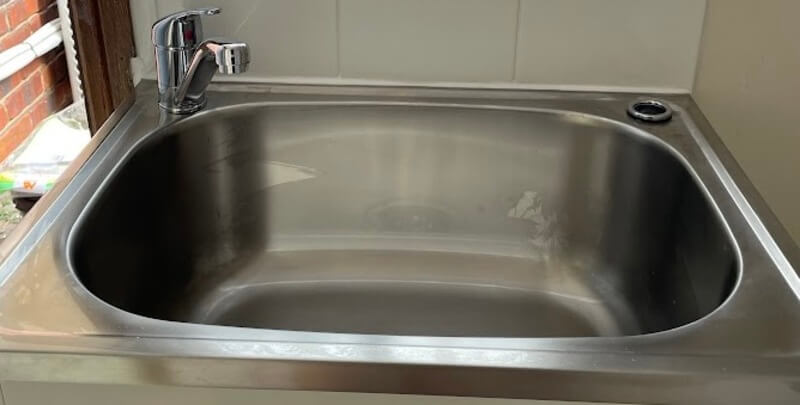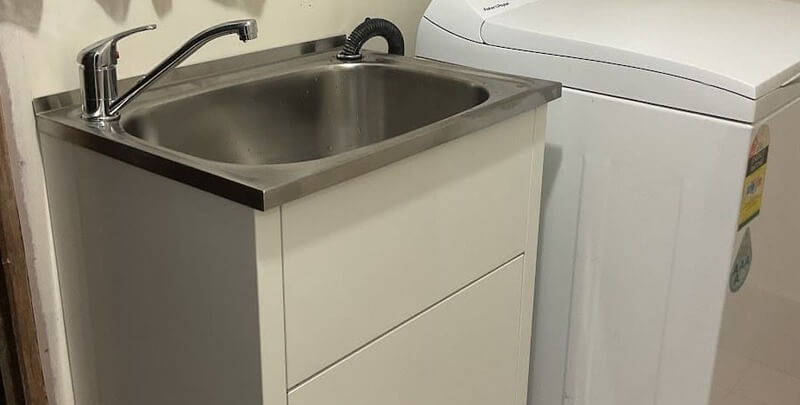
Laundry Taps Dripping Water
Leaky laundry taps can be a frustrating and worrisome problem. We've all been there: you're doing your laundry, and suddenly you notice water dripping from the taps or even forming a little puddle on the floor.
It’s not just an annoyance; a dripping tap can also lead to water damage and higher water bills if left unaddressed. That’s why understanding the reasons behind these leaks is crucial.
In this article, we’ll explore the common causes of dripping laundry taps and provide you with some helpful tips to diagnose and fix the issue. Whether you’re dealing with a minor drip or a persistent leak, we’ve got you covered. We’ll also discuss preventive measures to keep your taps in good shape and prevent future leaks.
So, if you’ve ever wondered why your laundry taps are leaking or want to know how to deal with this pesky problem, keep reading. Let’s dive into the world of laundry taps and discover how to fix a leaking tap and keep them leak-free.
Understanding Laundry Taps
Laundry taps play a crucial role in your laundry. These handy fixtures control the flow of water to your washing machine, allowing you to efficiently wash your clothes. But what exactly are laundry taps, and how do they work?
Laundry taps are valves that regulate the water supply to your washing machine. They typically have two handles, one for hot water and one for cold water, allowing you to adjust the temperature as needed. Some modern laundry taps even come with a single lever for easy temperature control.
These taps are usually connected to your home’s plumbing system and receive water from the main water supply. When you turn the handles, the valves inside the taps open, allowing water to flow into the washing machine. Once you’re done with the laundry, you turn the taps off, stopping the water supply.
Different types of laundry taps exist, including traditional compression taps, ball taps, and ceramic disc taps, each with its own mechanisms for controlling water flow. Understanding the type of tap you have can be helpful when diagnosing and fixing leaks.
Now that we have a basic understanding of laundry taps, let’s delve into why they might start leaking and how to fix a leaking tap effectively.
Signs of Leaking Laundry Taps
A leaking laundry tap is not something you want to ignore, whether its a leaking washing machine tap or sink tap. It can cause a range of problems if left unattended. So, how can you tell if your laundry taps are leaking?
Look out for these tell-tale signs:
- Dripping water: The most obvious sign is water dripping from the tap even when it’s turned off. A persistent drip indicates a leak that needs to be addressed.
- Puddles or water stains: Check the area around your laundry taps for puddles or water stains on the walls or floor, caused by all the residual water. These are signs that water is escaping from the taps and causing potential damage.
- Increased water bills: Keep an eye on your water bills. If you notice a sudden increase in usage without any changes in your water habits, it could be a sign of a hidden leak in your laundry taps.
- Mould or mildew: Leaky taps can create a damp environment, leading to the growth of mould or mildew. If you notice musty odours or dark spots near the taps, it’s a clear indication of a leak.
If you observe any of these signs, it’s important to take action promptly. In the next section, we’ll explore the common causes of leaking laundry taps and how to fix them.

Common Causes of Leaking Laundry Taps
Leaky laundry taps can be attributed to several underlying causes. Understanding these common culprits can help you identify and address the issue more effectively. Here are some potential causes of leaking laundry taps:
- Worn out or damaged tap washer and O-rings: Over time, the washers and O-rings inside the tap handles can deteriorate, resulting in leaks. These small rubber components create a watertight seal and may need replacing to fix the issue.
- Loose or faulty connections: Connections between the taps and the water supply pipes can become loose or develop cracks, leading to leaks. Inspecting and tightening these connections can often resolve the problem.
- High water pressure: Excessively high water pressure can put strain on the tap’s components, causing leaks. If your taps are constantly leaking, it might be worth checking your water pressure and considering installing a pressure regulator if needed.
- Corrosion or mineral build up: Over time, mineral deposits or corrosion can accumulate inside the taps, affecting their functionality and causing leaks. Regular cleaning and maintenance can help prevent this issue.
By understanding these common causes, you can take the necessary steps to fix your leaking washing machine taps. In the next section, we’ll guide you through the process of diagnosing and resolving the issue.
Diagnosing and Fixing the Issue
If you’re dealing with leaking laundry taps, it’s essential to diagnose the problem accurately and apply the appropriate solution before rushing off to the local hardware store.
Here’s a step-by-step guide to help you through the process:
- Turn off the water: Before you begin, turn off the water supply to the taps. This will prevent any further leakage and allow you to work safely.
- Inspect the tap handles: Check the handles for any visible signs of damage or wear. If you notice cracks or deterioration, it’s likely that the washers or O-rings need replacing.
- Replace tap washers and O-rings: Disassemble the tap handles and replace the worn-out or broken washer and O-rings with new ones. Ensure you choose the correct size and type for your taps.
- Tighten connections: Examine the connections between the tap body and the water supply pipes. Use a wrench to tighten any loose connections. Be careful not to over tighten and cause damage.
- Check for mineral build up: If there’s mineral build up inside the tap body, soak them in a vinegar solution to dissolve the deposits. Scrub gently with a brush to remove any remaining build up.
- Test for leaks: Once you’ve made the necessary repairs, turn on the water supply and test the taps for leaks. Observe them closely and ensure there are no drips or leaks.
If the issue persists or seems beyond your expertise, it’s best to seek the assistance of a professional plumber. They have the knowledge and tools to handle more complex problems and ensure a proper fix.
By following these steps, you can diagnose and address the issue with your leaking laundry taps. However, prevention is always better than cure. In the next section, we’ll discuss some preventive measures to keep your taps in good condition and avoid future leaks.

Preventing Future Leaks
Taking proactive steps to prevent future leaks in your laundry taps can save you from the hassle and potential damage. Here are some preventive measures you can implement:
- Regular maintenance: Inspect your laundry taps periodically for signs of wear or damage. Replace washers and O-rings as needed and clean any mineral build up to maintain optimal functionality.
- Monitor water pressure: Keep an eye on your home’s water pressure. Excessively high water pressure can strain the taps and lead to leaks. Consider installing a pressure regulator if necessary.
- Be gentle with handles: Avoid excessive force when turning the tap handles. Being too rough can damage the washers and O-rings, increasing the chances of leaks. Use gentle yet firm movements.
- Upgrade to water-efficient appliances: Consider investing in water-efficient washing machines and faucets. These appliances put less stress on the taps and reduce water usage, lowering the risk of leaks.
- Seek professional advice: If you’re unsure about any maintenance or repair tasks, don’t hesitate to consult a professional plumber or ask questions at your local hardware store. They can provide guidance on proper care and help you address any concerns.
By adopting these preventive measures, you can maintain your laundry taps in good working condition and minimise the likelihood of future leaks. Remember, proactive care is key to a leak-free laundry room. You’ll be saving water and reducing your water bill.
Keeping Your Laundry in Top Shape
Leaky laundry taps are a common household issue that can lead to water damage and higher utility bills if ignored. By understanding the causes of these leaks and taking prompt action, you can prevent further problems and keep your laundry room in tip-top shape.
In this article, we explored the reasons behind leaking laundry taps, from a worn-out tap washer to loose connections, high water pressure and mineral build up. We also provided you with practical tips on how to diagnose and fix the issue, from replacing washers and tightening connections to addressing mineral deposits.
Additionally, we discussed preventive measures such as regular maintenance, monitoring water pressure, and upgrading to water-efficient appliances.
Remember, if you encounter persistent leaks or are unsure about handling the repairs, it’s always wise to consult a professional plumber for assistance.
By staying proactive and addressing the leaky tap promptly, you can maintain a leak-free laundry room and enjoy the convenience of functional taps for years to come.
Finance Options** for Laundry Plumbing Services
If you need professional help with dripping taps in your laundry but it’s a bad time of year for your finances, Plumber Near Me has got you covered.
We offer a range of finance options** for eligible customers. Your attending plumber can take you through the easy application process on site and approval usually only takes a few minutes.
Then you can select a payment plan with one of our finance providers, Zip or HummLoan, and enjoy the convenience of making weekly, fortnightly or monthly instalments, depending on your choice of provider and plan.
We also accept payment by cash, cheque, direct transfer and credit card (Visa, Mastercard or American Express). Then Plumber Near Me can solve your plumbing issues.
Please note: This information is provided for advice purposes only. Regulations differ from state to state, so please consult your local authorities or an industry professional before proceeding with any work. See our Terms & Conditions here.